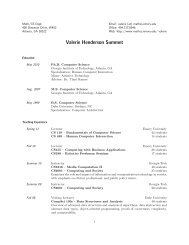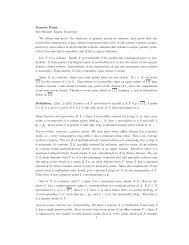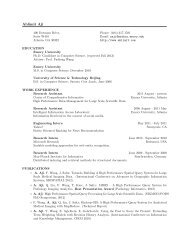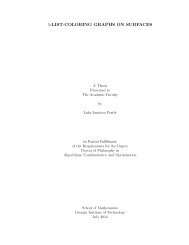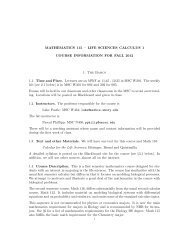Chapter 3 Solution of Linear Systems - Math/CS
Chapter 3 Solution of Linear Systems - Math/CS
Chapter 3 Solution of Linear Systems - Math/CS
You also want an ePaper? Increase the reach of your titles
YUMPU automatically turns print PDFs into web optimized ePapers that Google loves.
60 CHAPTER 3. SOLUTION OF LINEAR SYSTEMS<br />
What result is obtained if Gaussian elimination is applied to this linear system using floating–<br />
point arithmetic? To make pen-and-pencil computation easy, let us use round-to-nearest 4 significant<br />
digit decimal arithmetic. This means the result <strong>of</strong> every add, subtract, multiply, and divide is<br />
rounded to the nearest decimal number with 4 significant digits.<br />
Consider what happens if the exchange step is not used. The multiplier is computed exactly<br />
because the exact value <strong>of</strong> the multiplier<br />
1<br />
0.000025<br />
= 40000 rounds to itself; that is, the portion<br />
rounded-<strong>of</strong>f is 0. So, the elimination step <strong>of</strong> GE subtracts 40000 times equation 1 from equation 2.<br />
Now 40000 times equation 1 is computed exactly simply because multiplying by 1 is exact. So, the<br />
only rounding error in the elimination step is that produced when its subtraction is performed. In<br />
this subtraction the coefficient multiplying x2 in the second equation is 1 − 40000 = −39999, which<br />
rounds to −40000, and the right hand side is 2 − 40000 = −39998, which also rounds to −40000. So<br />
the result <strong>of</strong> the elimination step is<br />
0.000025x1 + 1x2 = 1<br />
0x1 + (−40000)x2 = −40000<br />
Backwards substitution commits no further rounding errors and produces the approximate solution<br />
x2 = 40000<br />
= 1<br />
40000<br />
x1 =<br />
1 − x2<br />
= 0<br />
0.000025<br />
Recall, the exact solution <strong>of</strong> the linear system has x1 ≈ 1, so this computed solution differs significantly<br />
from the exact solution.<br />
Why does the computed solution differ so much from the exact solution? Observe that the<br />
computed solution has x2 = 1. This is an accurate approximation <strong>of</strong> its exact value 39998<br />
39999 , but it is<br />
in error by an amount 39998<br />
1<br />
39999 −1 = − 39999 . When the approximate value <strong>of</strong> x1 is computed as<br />
cancellation occurs when the approximate value x2 = 1 is subtracted from 1. This cancellation is<br />
catastrophic.<br />
Now consider what happens if we include the exchange step. The result <strong>of</strong> the exchange step is<br />
the linear system<br />
1x1 + 1x2 = 2<br />
0.000025x1 + 1x2 = 1<br />
1−x2<br />
0.000025 ,<br />
The multiplier 0.000025<br />
1 = 0.000025 is computed exactly, as is 0.000025 times equation 1. The result<br />
<strong>of</strong> the elimination step is<br />
1x1 + 1x2 = 2<br />
0x1 + 1x2 = 1<br />
because, in the subtract operation <strong>of</strong> the elimination step, 1−0.000025 = 0.999975 rounds to 1 and 1−<br />
2 × 0.000025 = 0.99995 rounds to 1. Even with this approximate arithmetic, backwards substitution<br />
commits no further rounding errors and produces an accurate, but not exact, approximate solution<br />
x2 = 1<br />
x1 =<br />
2 − x2<br />
1<br />
Partial pivoting by rows for size is a heuristic that serves only as a guide to choosing the pivot.<br />
One explanation why this heuristic is generally successful is as follows. Given a list <strong>of</strong> candidates for<br />
the next pivot, those with smaller magnitude are more likely to have been formed by a subtract magnitude<br />
computation <strong>of</strong> larger numbers, so the resulting cancellation might make them less accurate<br />
than the other candidates for pivot. The multipliers determined by dividing by such smaller magnitude,<br />
inaccurate numbers will therefore be larger magnitude, inaccurate numbers. Consequently,<br />
elimination may produce large and unexpectedly inaccurate coefficients; in extreme circumstances,<br />
these large coefficients may contain little information from the coefficients <strong>of</strong> the original equations.<br />
While the heuristic <strong>of</strong> partial pivoting by rows for size generally improves the chances that GE<br />
will produce an accurate answer, it is neither perfect nor is it always better than any other (or even<br />
no) interchange strategy.<br />
= 1




